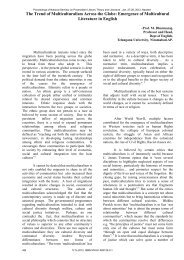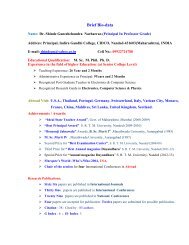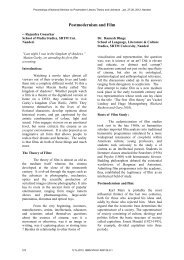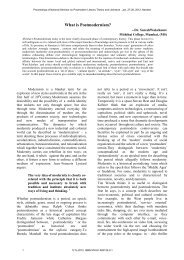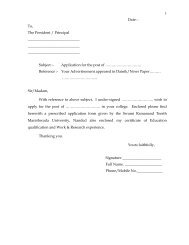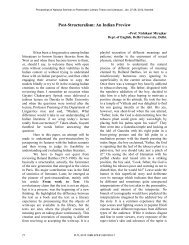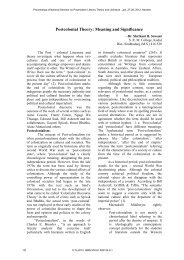Postcolonial Feminist Theory: An Overview - Igcollege.org
Postcolonial Feminist Theory: An Overview - Igcollege.org
Postcolonial Feminist Theory: An Overview - Igcollege.org
You also want an ePaper? Increase the reach of your titles
YUMPU automatically turns print PDFs into web optimized ePapers that Google loves.
Proceedings of National Seminar on Postmodern Literary <strong>Theory</strong> and Literature , Jan. 27-28, 2012, Nandeddivine a new home in Brewster Place byembracing and nurturing those who sharethat place with her. If, however, thesemarginalized communities do not own theirphysical spaces, theydo expand their definitions of family topeople 'homes' that extend through timerather than space. Children become thepromise of a future 'home' n the world inwhich they may live, and communal survivalbecomes the means to each that home.Consequently, Mattie is willing to suffer andeven die to enable her children and othermembers of her extended concept of familyto continue the struggle to tear down thewalls that confine them. This is to claim ahome in a future they strive to make a realpossibility.IIIMama Day too is, in many ways, related tocommunity and voices. In a magicoreligiousmanner, Gloria Naylor presents ahealthy, alternative community in this novelwhich points out the short-sightedness ofethnographers. Lindsay Tucker explains howNaylor divines a different community inMama Day with the help of narrativestrategy and collective voice:For example, the collective voice,which introduced the reader to thecommunity of Willow Springs,concludes with a critique ofethnography and its methodologies.The failure of the ethnographer is dueto his inability to hear and to ask theright questions, a failing that, the voiceseems to warn us, may be our own:".....he could listen to them," the voiceexplains, "the way you been listeningto us right now. Think about it: ain'tnobody really talking to you". 10 1Naylor also depicts a group of conjures inMama Day. Ruby, Dr. Buzzard, thematernal ancestor Sapphira Wade and MamaDay figure prominently in the novel. Theseconjures brings a new perspective into thenarrative and they also help Naylor toconstruct an Afro-centric community in thenovel. The conjurers in Mama Day bringforth a different community in WillowSprings, the members of which have strongfaith in African medicinal practices, beliefsystems, religion and ancestry.Conjuration also has some significance in thecontext of space. It creates narrative spaceand linguistic space within the community.Naylor finds for her conjures enough spaceswithin the framework of the folktale. Sherips open the patriarchal territory of folktaleand gives conjure women such as MirandaRuby visible textual presence.Mama Day deals with space and communityin another way too. Naylor dissolves thebinaries of past and present, and magic andreal – all the boundaries of conventionalnarratives. Naylor's attempt on theboundaries of narratives can also be seen asher attempt on the boundaries of space withina tradition – patriarchal or capitalist tradition.Lindsey Tucker also notes this complexmetaphor involving language, narrative,space and community in Mama Day:...4...Naylor's employment of a communalvoice allows her to establish MamaDay's rootedness in the place, sincethis voice not only gathers up themany voices of the community, pastand present, but allows theconsciousness of Mama Day to comethrough when it is important to do so. Thusthe communal voice succeeds indemolishing the boundaries betweenomniscient and limited-omniscientpoints of view, even as the novel'ssubject matter demolishes theboundaries between the mimetic andthe magical. 2Mama Day also evokes a community thatdraws its spiritual and mental strength fromthe African heritage. Naylor makes WillowSprings look estranged from the mainlandand the people living in this island preferringnot to be aligned with American communitypatterns. Amy Levin identified the ideologybehind the community life in Willow Springsas Africanism. She writes:In Naylor's Mama Day, thecommunity of Willow Springs reflectsthe value and power relations evidentin West African women's societies.Allusions to Africa are indirect andappear trough metonyms and291 PLTL-2012: ISBN 978-81-920120-0-1



